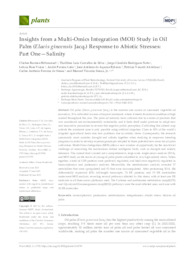Insights from a Multi-Omics Integration (MOI) Study in Oil Palm (Elaeis gineensis Jacq.) Response to Abiotic Stresses: Part One?Salinity.
Insights from a Multi-Omics Integration (MOI) Study in Oil Palm (Elaeis gineensis Jacq.) Response to Abiotic Stresses: Part One?Salinity.
Autoria: BITTENCOURT, C. B.; SILVA, T. L. C. da; RODRIGUES NETO, J. C.; VIEIRA, L. R.; LEAO, A. P.; RIBEIRO, J. A. de A.; ABDELNUR, P. V.; SOUSA, C. A. F. de; SOUZA JUNIOR, M. T.
Resumo: Oil palm (Elaeis guineensis Jacq.) is the number one source of consumed vegetable oil nowadays. It is cultivated in areas of tropical rainforest, where it meets its natural condition of high rainfall throughout the year. The palm oil industry faces criticism due to a series of practices that was considered not environmentally sustainable, and it finds itself under pressure to adopt new and innovative procedures to reverse this negative public perception. Cultivating this oilseed crop outside the rainforest zone is only possible using artificial irrigation. Close to 30% of the world?s irrigated agricultural lands also face problems due to salinity stress. Consequently, the research community must consider drought and salinity together when studying to empower breeding programs in order to develop superior genotypes adapted to those potential new areas for oil palm cultivation. Multi-Omics Integration (MOI) offers a new window of opportunity for the non-trivial challenge of unraveling the mechanisms behind multigenic traits, such as drought and salinity tolerance. The current study carried out a comprehensive, large-scale, single-omics analysis (SOA), and MOI study on the leaves of young oil palm plants submitted to very high salinity stress. Taken together, a total of 1239 proteins were positively regulated, and 1660 were negatively regulated in transcriptomics and proteomics analyses. Meanwhile, the metabolomics analysis revealed 37 metabolites that were upregulated and 92 that were downregulated. After performing SOA, 436 differentially expressed (DE) full-length transcripts, 74 DE proteins, and 19 DE metabolites ffected by this stress, with at least one DE molecule in all three omics platforms used. The Cysteine and methionine metabolism (map00270) and Glycolysis/Gluconeogenesis (map00010) pathways were the most affected ones, each one with 20 DE molecules.
Ano de publicação: 2022
Tipo de publicação: Artigo de periódico
Unidade: Embrapa Agroenergia
Palavras-chave: Abiotic stress, African oil palm, Integratomics, Metabolomics, Proteomics, Transcriptomics
Observações
1 - Por padrão são exibidas publicações dos últimos 20 anos. Para encontrar publicações mais antigas, configure o filtro ano de publicação, colocando o ano a partir do qual você deseja encontrar publicações. O filtro está na coluna da esquerda na busca acima.
2 - Para ler algumas publicações da Embrapa (apenas as que estão em formato ePub), é necessário ter, no celular ou computador, um desses softwares gratuitos. Sistemas Android: Google Play Livros; IOS: iBooks; Windows e Linux: software Calibre.
Acesse outras publicações
Acesse a Base de Dados da Pesquisa Agropecuária (BDPA) para consultar o acervo completo das bibliotecas da Embrapa.

